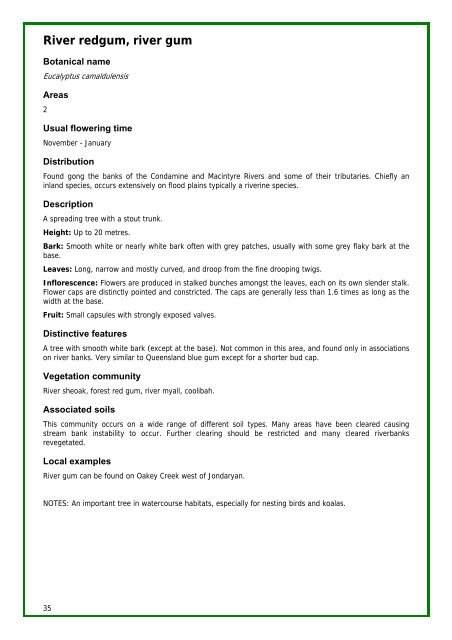Tree identification manual - North East Downs Landcare Group
Tree identification manual - North East Downs Landcare Group
Tree identification manual - North East Downs Landcare Group
You also want an ePaper? Increase the reach of your titles
YUMPU automatically turns print PDFs into web optimized ePapers that Google loves.
River redgum, river gum<br />
Botanical name<br />
Eucalyptus camaldulensis<br />
Areas<br />
2<br />
Usual flowering time<br />
November - January<br />
Distribution<br />
Found gong the banks of the Condamine and Macintyre Rivers and some of their tributaries. Chiefly an<br />
inland species, occurs extensively on flood plains typically a riverine species.<br />
Description<br />
A spreading tree with a stout trunk.<br />
Height: Up to 20 metres.<br />
Bark: Smooth white or nearly white bark often with grey patches, usually with some grey flaky bark at the<br />
base.<br />
Leaves: Long, narrow and mostly curved, and droop from the fine drooping twigs.<br />
Inflorescence: Flowers are produced in stalked bunches amongst the leaves, each on its own slender stalk.<br />
Flower caps are distinctly pointed and constricted. The caps are generally less than 1.6 times as long as the<br />
width at the base.<br />
Fruit: Small capsules with strongly exposed valves.<br />
Distinctive features<br />
A tree with smooth white bark (except at the base). Not common in this area, and found only in associations<br />
on river banks. Very similar to Queensland blue gum except for a shorter bud cap.<br />
Vegetation community<br />
River sheoak, forest red gum, river myall, coolibah.<br />
Associated soils<br />
This community occurs on a wide range of different soil types. Many areas have been cleared causing<br />
stream bank instability to occur. Further clearing should be restricted and many cleared riverbanks<br />
revegetated.<br />
Local examples<br />
River gum can be found on Oakey Creek west of Jondaryan.<br />
NOTES: An important tree in watercourse habitats, especially for nesting birds and koalas.<br />
35


